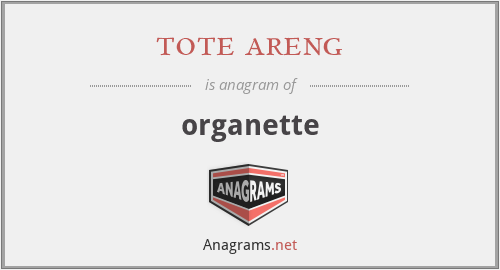What anagrams are available for organette?
This page is about an anagram for the word tote areng that can be used in word games, puzzles, trivia and other crossword based board games.
tote areng
Translation
Find a translation for tote areng in other languages:
Select another language:
- - Select -
- 简体中文 (Chinese - Simplified)
- 繁體中文 (Chinese - Traditional)
- Español (Spanish)
- Esperanto (Esperanto)
- 日本語 (Japanese)
- Português (Portuguese)
- Deutsch (German)
- العربية (Arabic)
- Français (French)
- Русский (Russian)
- ಕನ್ನಡ (Kannada)
- 한국어 (Korean)
- עברית (Hebrew)
- Gaeilge (Irish)
- Українська (Ukrainian)
- اردو (Urdu)
- Magyar (Hungarian)
- मानक हिन्दी (Hindi)
- Indonesia (Indonesian)
- Italiano (Italian)
- தமிழ் (Tamil)
- Türkçe (Turkish)
- తెలుగు (Telugu)
- ภาษาไทย (Thai)
- Tiếng Việt (Vietnamese)
- Čeština (Czech)
- Polski (Polish)
- Bahasa Indonesia (Indonesian)
- Românește (Romanian)
- Nederlands (Dutch)
- Ελληνικά (Greek)
- Latinum (Latin)
- Svenska (Swedish)
- Dansk (Danish)
- Suomi (Finnish)
- فارسی (Persian)
- ייִדיש (Yiddish)
- հայերեն (Armenian)
- Norsk (Norwegian)
- English (English)
Definition
What does organette mean?
- Organette
- The Organette was a mechanical free-reed instrument first manufactured in the late 1870s by several companies such John McTammany of Cambridge MA, the Autophone Company of Ithaca NY, the Automatic Organ Co of Boston MA, E.P. Needham & Sons of New York NY, J.M. Draper of Blackburn, England, Paul Ehrlich & Co. of Leipzig Germany, and The Mechanical Orguinette Co. of New York NY as well as other manufacturers worldwide.The organette (or orguinette) used rolls of perforated paper, perforated cardboard, perforated metal disks and wooden rollers (or "cobs") on which the music was recorded. Musical scales ranged from 14 to 39 notes depending on the instrument's complexity. Air pressure or vacuum was produced by hand-, crank- or foot-operated mechanical bellows. The organette was compact and affordable with large selections of music available. Various patents credit Henry Bishop Horton (1819-1885; co-founder of the Ithaca Calendar Clock Co), John McTammany (1845-1915), Paul Ehrlich and others with inventing the organette. The organette's popularity declined as the phonograph was introduced and became more affordable. The most remarkable feature of this invention is the regularity and perfection with which the music is rendered. All of the parts are played and the music is of no mean order. Scientific American (19 November 1879)
Embed
Citation
Use the citation below to add this anagram to your bibliography:
Style:MLAChicagoAPA
"tote areng." Anagrams.net. STANDS4 LLC, 2024. Web. 18 May 2024. <https://www.anagrams.net/term/9373307>.



Discuss this organette anagram with the community:
Report Comment
We're doing our best to make sure our content is useful, accurate and safe.
If by any chance you spot an inappropriate comment while navigating through our website please use this form to let us know, and we'll take care of it shortly.
Attachment
You need to be logged in to favorite.
Log In